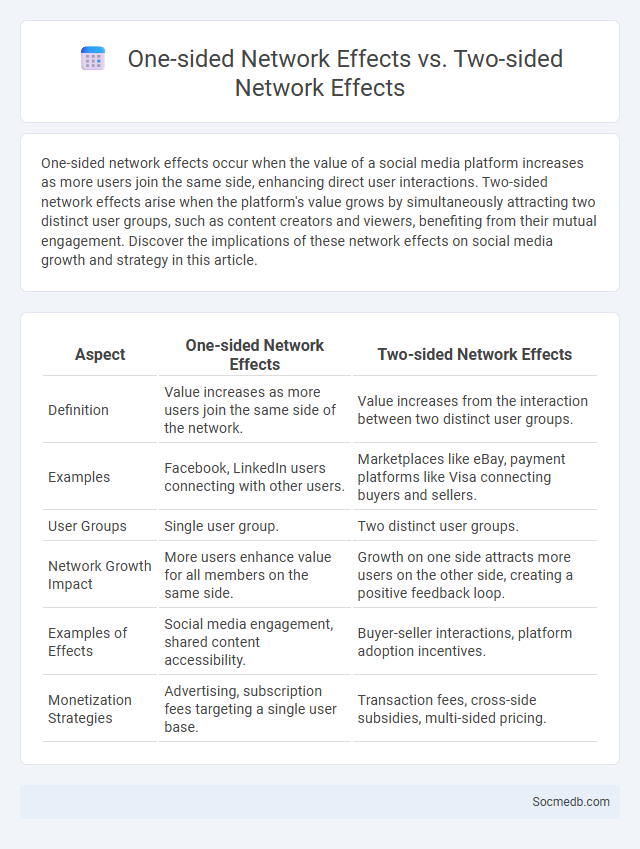
Photo illustration: One-sided Network Effects vs Two-sided Network Effects
One-sided network effects occur when the value of a social media platform increases as more users join the same side, enhancing direct user interactions. Two-sided network effects arise when the platform's value grows by simultaneously attracting two distinct user groups, such as content creators and viewers, benefiting from their mutual engagement. Discover the implications of these network effects on social media growth and strategy in this article.
Table of Comparison
| Aspect | One-sided Network Effects | Two-sided Network Effects |
|---|---|---|
| Definition | Value increases as more users join the same side of the network. | Value increases from the interaction between two distinct user groups. |
| Examples | Facebook, LinkedIn users connecting with other users. | Marketplaces like eBay, payment platforms like Visa connecting buyers and sellers. |
| User Groups | Single user group. | Two distinct user groups. |
| Network Growth Impact | More users enhance value for all members on the same side. | Growth on one side attracts more users on the other side, creating a positive feedback loop. |
| Examples of Effects | Social media engagement, shared content accessibility. | Buyer-seller interactions, platform adoption incentives. |
| Monetization Strategies | Advertising, subscription fees targeting a single user base. | Transaction fees, cross-side subsidies, multi-sided pricing. |
Understanding Network Effects: An Overview
Network effects occur when the value of a social media platform increases as more users join, creating a self-reinforcing cycle of user growth and engagement. Platforms like Facebook and Instagram leverage these effects by encouraging interactions such as sharing, commenting, and connecting, which enhances user retention and attracts new members. Understanding these network effects is crucial for developing strategies that maximize user acquisition and platform value.
Defining One-sided Network Effects
One-sided network effects occur when the value of a social media platform increases as more users join the same network, directly enhancing user experience and engagement. As the user base expands, interactions, content sharing, and connections become richer, driving organic growth and platform loyalty. This positive feedback loop is crucial for the rapid scaling and sustainability of social media ecosystems.
Defining Two-sided Network Effects
Two-sided network effects occur when the value of a social media platform increases as both user groups--content creators and consumers--grow simultaneously. This mutual enhancement drives engagement, attracting more creators who produce diverse content and more users who consume and share that content. Platforms like Instagram and TikTok exemplify this dynamic, leveraging interactive features to amplify network effects and boost user retention.
Key Differences Between One-sided and Two-sided Network Effects
One-sided network effects occur when the value of a social media platform increases solely as more users join, enhancing your interaction potential within a single user group. Two-sided network effects emerge in platforms connecting two distinct groups, such as content creators and consumers, where the participation of each side boosts the overall ecosystem value. Understanding these differences helps optimize your engagement strategies, tailoring actions to leverage user base growth or cross-group interactions effectively.
Examples of One-sided Network Effects
Platforms like Instagram benefit from one-sided network effects where each new user adds value primarily to existing users by increasing content diversity and engagement, enhancing Your social media experience. Twitter's user base growth intensifies interactions across tweets, replies, and retweets, amplifying network utility for all participants without the need for a distinct user group. Similarly, TikTok's expanding community drives an abundance of user-generated content, making the platform more valuable for viewers as more creators join.
Examples of Two-sided Network Effects
Social media platforms like Facebook and Instagram exhibit two-sided network effects by connecting users and advertisers, where the value increases as more users join, attracting more advertisers seeking targeted audiences. You benefit from engaging content and personalized ads, while businesses gain access to a growing user base, enhancing their marketing reach. This mutual reinforcement drives platform growth and innovation, making the network more valuable for all participants.
Impact of Network Effects on Platform Growth
Network effects significantly drive the growth of social media platforms by increasing user engagement as more individuals join and interact. Your ability to connect with a larger audience enhances the platform's value, creating a cycle where increased user activity attracts even more users. This exponential growth catalyzes platform dominance and influences user retention strategies.
Challenges in Leveraging Network Effects
Social media platforms face significant challenges in leveraging network effects, such as user retention difficulties and content moderation complexities. The imbalance between active contributors and passive consumers often hampers growth and engagement, limiting the platform's viral potential. Privacy concerns and algorithm biases further complicate sustaining positive network externalities essential for exponential user expansion.
Strategies to Strengthen Network Effects
Leveraging user-generated content and incentivizing referrals significantly amplify social media network effects by increasing active participation and organic growth. Implementing algorithmic personalization enhances user engagement, encouraging longer session times and stronger community bonds. Strategic partnerships and seamless cross-platform integrations expand user reach, creating a more interconnected and valuable social ecosystem.
Future Trends in Network Effects and Platform Economies
Future trends in social media emphasize enhanced network effects driven by AI-powered personalization and immersive augmented reality experiences, increasing user engagement and retention. Platform economies are shifting toward decentralized models using blockchain technology, empowering users with greater data ownership and new monetization opportunities. Your ability to navigate these evolving ecosystems will be critical for leveraging emerging social platforms to maximize influence and economic value.
 socmedb.com
socmedb.com